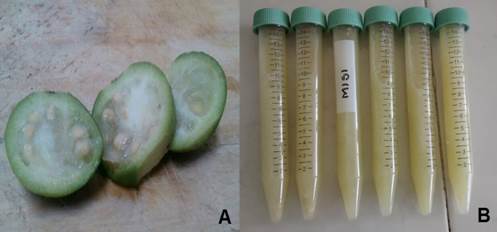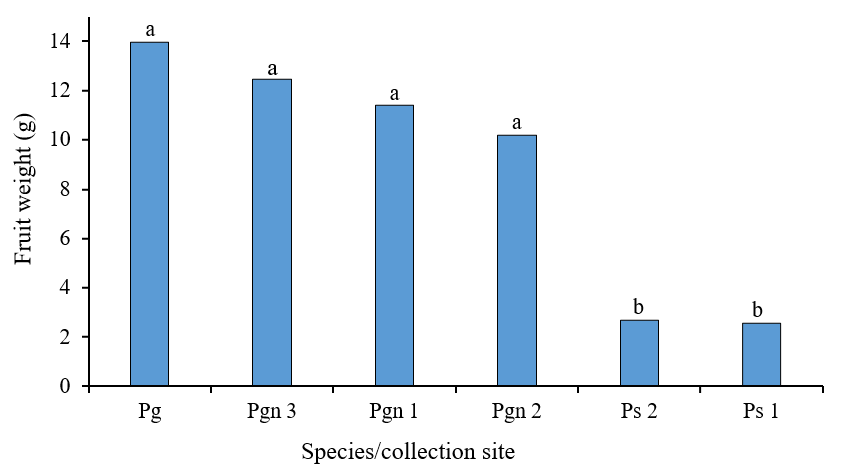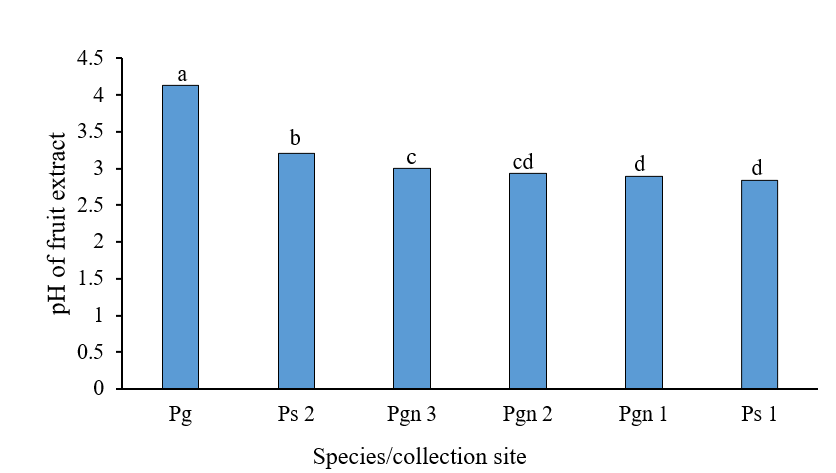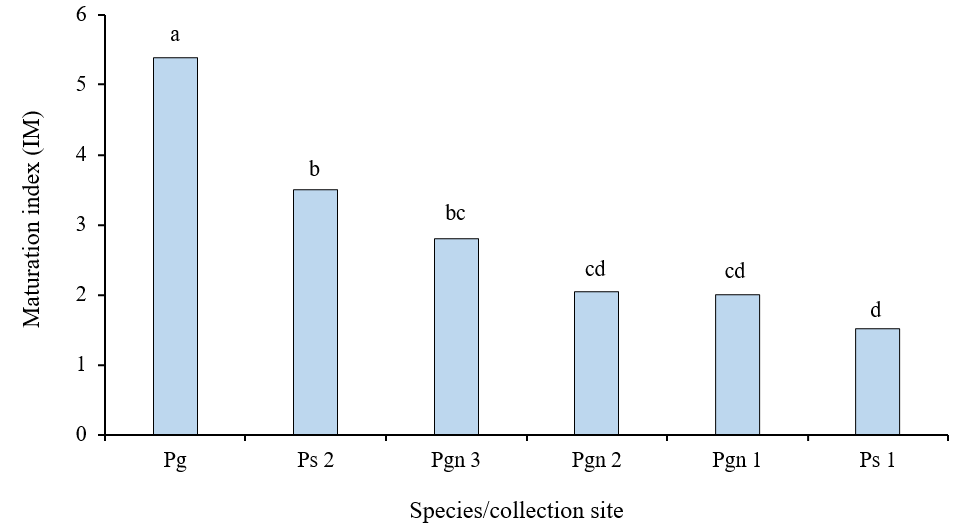Servicios Personalizados
Revista
Articulo
Indicadores
-
 Citado por SciELO
Citado por SciELO -
 Accesos
Accesos
Links relacionados
-
 Similares en
SciELO
Similares en
SciELO
Compartir
Revista mexicana de ciencias agrícolas
versión impresa ISSN 2007-0934
Rev. Mex. Cienc. Agríc vol.9 no.6 Texcoco ago./sep. 2018
https://doi.org/10.29312/remexca.v9i6.1576
Articles
Physicochemical properties of guayabilla (Psidium guineense), myrtle (Psidium sartorianum) and guava (Psidium guajava)
1El Llano Technological Institute, Aguascalientes. Highway Aguascalientes-San Luis Potosí km 18, El Llano, Aguascalientes. CP. 20330. (silviaenriquez.mc@gmail.com; silosespino@hotmail.com; cperales55@hotmail.com; sfbenitez@gmail.com).
2National Institute of Forestry, Agriculture and Livestock Research. Highway Aguascalientes-Zacatecas km 32, Pabellón de Arteaga, Aguascalientes. CP. 20670. (jsaulpr@yahoo.com).
In order to determine the possible use of guayabilla (Psidium guineense) and myrtle (P. sartorianum) in innovation for the generation of food products, the physicochemical properties of fruits of these species were compared with those of guava (Psidium guajava). For this, five wild fruit collection sites were selected in the municipality of Talpa, Jalisco. The hypothesis was that the levels of citric acid and ripening index could be higher in guayabilla and myrtle, while the sugar content could be higher in guava. The experimental design used was a completely randomized one with a number of fruits that varied depending on the trees of the species present in each site. The obtained means were compared by the Tukey test p= 0.05. The acidity observed in mature fruits of Psidium sartorianum and Psidium guineense ranged between pH 2.84 to 3.21, while in guava a pH of 4.13 (less acidic) was observed. The titratable acidity obtained was congruent with the pH, since at lower values of titratable acidity correspond the lower pH values. Despite the acidity of the fruits of Psidium sartorianum, one of the collection sites showed a total soluble solids index (7.4 °Brix) higher than that of guava (5.32 °Brix). The ripening index was higher for guava, in contrast to the low values found in Psidium guineense and Psidium sartorianum. Finally, Psidium guajava presented larger fruits than the two-wild species.
Keywords: Psidium guajava; Psidium guineense; Psidium sartorianum; antioxidant capacity; total soluble solids
A fin de determinar la posible utilización de guayabilla (Psidium guineense) y arrayán (Psidium sartorianum) en la innovación para la generación de productos alimenticios, las propiedades fisicoquímicas de frutos de estas especies fueron comparadas con las de guayaba (Psidium guajava). Para esto, se seleccionaron cinco sitios de colecta de fruta las especies silvestres en el municipio de Talpa, Jalisco. La hipótesis planteada fue que los niveles de ácido cítrico e índice de maduración podrían ser superiores en guayabilla y arrayán, mientras que el contenido de azúcar podría ser mayor en guayaba. El diseño experimental utilizado fue un completamente al azar con un número de frutos que varió en función de los árboles de las especies presentes en cada sitio. Las medias obtenidas fueron comparadas mediante la prueba de Tukey p= 0.05. La acidez observada en frutos maduros de P. sartorianum y P. guineense osciló entre pH 2.84 a 3.21, mientras que en guayaba se observó un pH 4.13 (menos ácida). La acidez titulable obtenida fue congruente con el pH, pues a mayores valores de acidez titulable corresponden los menores valores de pH. A pesar de la acidez de los frutos de P. sartorianum, uno de los sitios de colección mostró un índice de solidos solubles totales (7.4 °Brix) superior al de guayaba (5.32 °Brix). El índice de maduración fue superior para guayaba, en contraste a los valores bajos encontrados en P. guineense y P. sartorianum. Finalmente, P. guajava presentó frutos más grandes que las dos especies silvestres.
Palabras clave: Psidium guajava; Psidium guineense; Psidium sartorianum; capacidad antioxidante; sólidos solubles totales
Introduction
Mexico allocates 21 624 hectares to the cultivation of guava (Psidium guajava L.), making this country one of the first ten main producers, located in third place after India and Pakistan (SAGARPA, 2012). In addition to the guava, other wild species of Psidium are present in the zones mainly from the tropical deciduous forest to the mesophilic mountain forest in our country. One of these species is ‘guayabilla’ (Psidium guineense, Sw), a tree that can be between 1 and 3 m tall with small, acid, rounded or pungent fruits (Morton, 1987).
This species is found from the coastal areas to the high zones of the state of Jalisco (Ramírez and Cupul, 1999; Téllez and Delgado, 2011) and its use as food in Mexico is scarce due to its acid taste when compared to the guava of table. In other countries, it is intended to promote its use both as unprocessed or processed food, mainly in rural areas, and if possible, to achieve its consumption in urban areas (Franzon et al., 2009).
However, P. guineense like guava, is recognized worldwide for its medicinal properties, since the juice of its fruit is used against stomach pain and as an anti-dysenteric. The infusion of its leaves, roots and bark is used against diarrhea and cough (Jaiarj et al., 1999; DeFilipps, et al., 2004; Neira-González and Ramírez-González, 2005; Neira-González et al., 2005; Pérez et al., 2008).
Another member of the genus is the myrtle (P. sartorianun O. Berg Nied), which is distributed along the coast of Jalisco (Hernández et al., 2006), its fruit is not as acid as the guayabilla and has a sweet aroma which makes this small fruit very attractive. Myrtle fruits are used to make sweets, syrups, tamales, ice cream, popsicles and fresh water (Rebollar et al., 2013). In addition, like guava and guayabilla, this species has been used in the same way for the treatment of diarrhea, coughs, ulcers and some other diseases (Delgado-Vargas et al., 2005).
Of these three species, guava (P. guajava, L.) is cultivated in 19 states of the Mexican Republic, but 90% of the total area reported (20 899 ha) is in Michoacán, Aguascalientes and Zacatecas. For its part, the myrtle is cultivated only in Nayarit with 94 reported officially (SIAP, 2015). However, in other regions of Mexico this fruit produced in the wild is exploited since there is no special care with trees (Rebollar et al., 2013). In the case of guayabilla there are no reports of its cultivation or consumption of this fruit in Mexico, its consumption is rather as an infusion of both the fruit and vegetative parts for medicinal purposes.
Other countries such as Ecuador, Bolivia and some of Central America exploit the fruit for the traditional preparation of syrups, liquor and jams or have small industrial farms for the production of organic products including chocolates stuffed with guayabilla, as is the case of the Mashpi® product (Chizmar et al., 2009; Mindala, 2015) that has been presented at the Slow Food Expo in Italy, dedicated to the sustainable production of food (Slow Food Expo, 2016).
Because both the myrtle and the guayabilla remain in Mexico as wild species with low domestication and low consumption, the potential for expansion of the cultivated areas of myrtle beyond the few hectares in Nayarit is still small. On the other hand, the potential of the guayabilla as a crop is still uncertain.
Therefore, promoting the medicinal and nutritional (nutraceutical) properties of the guayabilla and the myrtle could be a way to increase the interest in these species that could contribute to the economy of rural people by developing small businesses similar to those that they exist in Calvillo (Aguascalientes), where liquor, biscuits, sweets, jams and related products are produced from guava.
Based on the above, the objective of this work was to compare the physicochemical properties of guava, guayabilla and myrtle in order to derive useful data for the preparation of traditional products or innovation from these natural resources. Additionally, the accumulated knowledge about these fruits allows us to propose the hypothesis that in the fruits of guayabilla and myrtle there is a greater amount of citric acid and its ripening index will be higher than that of guava.
Materials and methods
Vegetal material
Mature fruits of guayabilla and Myrtle were collected during november 2013 in hills on the sides of the rural road from Talpa to The Cuale, located in the stretch between 12 and 18 km west of Talpa, Jalisco. The guayabilla fruits were collected from compact groups of shrubs that appear in a continuous canopy. On the other hand, the myrtle fruits were collected in the North and South urban limits of the Talpa population, collecting only those in mature state with bright yellow color and soft to the touch. All the fruits were placed in plastic bags labeled and placed in a cooler, separating the fruits of each tree individually. Finally, the ripe fruits of guava of average size were obtained in a supermarket in Aguascalientes.
The fruits were weighed and washed with liquid detergent for hands and disinfected for 20 min with 1% chlorine. The pulp was homogenized in a blender and placed in ziplock plastic bags (Ziploc®) in dark conditions at -20 °C. For physicochemical analyzes, 24 g of pulp dissolved in 60 mL of distilled water 1/2.5, w/v (Kuskoski et al., 2005) and centrifuged at 3 500 rpm for 10 min were used, the supernatant was preserved at -20 °C until the moment of use (Figure 1).

Figure 1 A) cut acidic guayabite for crushing; and B) homogenization of the pulp for physicochemical analyzes.
Physicochemical analysis
Total soluble solids (°Brix or SST). The index of total soluble solids in fruits and the refractometer method for fruit products were taken as reference (AOAC 1995, Official Method 932.12), using a VE-2S digital refractometer (ABBE / ZWAJ). For this, two mL of sample were kept at 20 °C and a few drops were placed in the reservoir of the refractometer sample in order to make the measurements.
Titratable acidity (TAA, AOAC 1995, Official Method 967.21). Five milliliters of the extract (equivalent to 2 g of pulp) and four drops of phenolphthalein were mixed before titration with 0.1 N NaOH. The titratable acidity was calculated as follows: (%) titratable acidity= [mL NaOH used] x [0.1 N NaOH] x [0.064 meq citric acid] x [100]/gram of sample. The result is expressed as the content of citric acid in percentage, since the acidity in fruits is mainly due to this compound (Garner et al., 2008).
Maturity index based on SST/AT. This index was calculated with the formula IM= SST/AT, also defined as °Brix/titrable acidity (Rapisarda et al., 2001; Casquero and Guerra, 2009).
pH. Determined using a pH meter (HI 2210, Hanna) according to the AOAC method (Official Method 981.12).
Analysis of data
The treatments consisted of five collections of wild genotypes of Psidium (guayabilla and myrtle) in Talpa, Jalisco, obtained in November 2013, with different number of specimens per collection site, depending on the availability of mature fruits well-formed and without apparent damage. These samples were obtained randomly, each fruit constituting a repetition for the morphological measurements. On the other hand, the fruits of cultivated guava were used as control and were obtained from a supermarket in Aguascalientes. The data were analyzed in a completely randomized design, and multiple comparisons were made using Tukey’s method p= 0.05 (Steel and Torrie, 1980, Howell, 2010), with the Minitab 16 package.
Results and discussion
Fruit weight
The fruits of cultivated guava were, at first sight, bigger and attractive in color and smell than those of guayabilla collected. However, no significant differences in weight were found between these two species (Figure 2). This is interesting given that the weight of mature fruit is distinctive between cultivated species and wild species, but there is a possibility that the fruits of ripe Talpa guayabillas are relatively large, since the average weight of P. guineense from at least two sites of the reported collections in this work were higher than the one mentioned by Damiani et al. (2011), who reported 10.7 g fruit-1 averaging 35 collection sites in Minas Gerais, Brazil.

Figure 2 Average fruit weight (g) of Psidium guajava (Pg), P. guineense (Pgn three collection sites) and P. sartorianum (Ps two collection sites). Means marked with the same letter are not significantly different when compared using the Tukey method, p< 0.05).
This difference is interesting because the cultivated genotypes tend to present large fruits in comparison to wild ones due to selection pressure (Sánchez et al., 2007). On the other hand, both collections of myrtle (P. sartorianum) showed a bright yellow color and the characteristic smell of ripe fruit and the average weight obtained from both sites was similar to each other, but statistically different from the weights of guava and guayabilla.
pH of the fruit extract
Both P. sartorianum and P. guineense have acid pH pulp that can be confirmed organoleptically. However, the acidity of the fruits differed between collection sites for myrtle P. sartorianum (Figure 3), but it could be influenced by the genotype of the individuals that differ enough from each other and that are distant around 2 km or 20 in geographic coordinates. The fruits collected south of the Talpa population were the most acidic (Ps 1). In the case of the guayabilla, the inhabitants of Talpa also call it ‘sour guava’ and this one showed a pH in the range of 2.89-3 considering the three collection sites.

Figure 3 pH of the fruit extract. Pg= Psidium guajava, Pgn= P. guineense (three collection sites) and Ps= P. sartorianum (two collection sites). Means marked with the same letter are not significantly different (Tukey; p< 0.05).
These values contrast with pH 3.99 (pulp) and 3.76 (husk) reported for this species by Damiani et al. (2011). As expected from the control, the guava presented an average pH of 4.13, less acid than the other species, but still in the range of acid values. Also, guava from Aguascalientes was less acidic than others reported as the variety ‘Paluma’ (pH 3.6) from Brazil (Ferreira et al., 2014), but similar to the values reported by Soares et al. (2007), who found a pH 4.07 for commercial guava in Brazil.
Total soluble solids (SST)
The myrtle (P. sartorianum) showed the highest SST index when comparing against the rest of the species (Figure 4). This result was not as expected because the sugar content and pH increase during the course of ripening making the fruits sweeter and less acidic. Previous reports of P. guajava indicate that SST values ranged between 7.0-8.8 °Brix in fresh pulp (Kadam et al., 2012; Ali et al., 2014) in contrast, in this work a lower value was found for this species (5.32 °Brix). Although the guayabilla fruits were collected mature with soft tissues, and some of them were collected from the floor (they fell freely from the tree). Their SST values were lower than that of other species, with some differences between the collection sites (Figure 4). Previous reports for this species averaged 10.7 °Brix (Damiani et al., 2011).
Titratable acidity (AT)
In this work, guava P. guajava showed similar results of AT to previous reports that mention the range of 0.26-0.39% of pulp (Mahajan et al., 2011). On the other hand, the rest of the species showed high values that are consistent with the pH of the species observed. The best example was myrtle P. sartorianum (Ps 1) with the highest value (3.52%) of AT and the lowest value of pH 2.84 (Figures 3, 5). The group of guayabillas together with a myrtle (Pgn 1-3 and Ps 2) was different from guava (Pg). However, the guayabilla AT values in this work were superior to those previously reported (0.52% pulp, 0.74% peel) (Damiani et al., 2011).
Maturity index (IM)
The maximum value of IM was found in the commercial guava (P. guajava), which was statistically different from the rest of the species (Figure 6). The rest of the species were grouped into three overlapping groups. The guayabilla values of the three statistically similar collection sites, while the two myrtle collections were different from each other. As previously mentioned, these results were mainly influenced by the titratable acidity, since both P. guineense and P. sartorianum presented high acidity despite the fact that the fruits were mature and had soft pulp.
Conclusions
According to the results of this work, the guayabilla and myrtle fruits remain acidic even after they have matured and their titratable acidity was consistent with their low pH values. For this characteristic, the guayabilla is called by some of the inhabitants of Talpa ‘sour guava’ and its consumption is restricted in that place. It is, therefore, imperative to promote its consumption in the form of derivatives in the form of sweets, jellies and other products in order to generate interest from the inhabitants of the areas where these trees are endemic and that this germplasm is not lost. also incorporate guava genetic improvement programs.
It is interesting to find that the Myrtle fruits analyzed contained the highest levels of total soluble solids, since it was expected that these values corresponded to fruits with lower acidity as is the case of guava. This high sugar content explains in part its acceptance by the Mexican public and why it is starting its production in commercial form specifically in Nayarit (SIAP, 2015) but still its consumption is mainly seasonal.
On the other hand, the maturity index (IM= SST/AT) was clearly higher in the guava compared to the guayabilla and the myrtle. However, the highest value found for guava does not compare with the SST/AT values reported for other species such as the case of red orange that had values from 8.0 to 11.5, or plum with more than 9.0, depending on the time of storage. These relatively low IM values of the three Psidium species could be related to their high titratable acidity index.
Acknowledgments
We thank the National Technological Institute of Mexico for the institutional support for the development of this project. Also, the support of Ing. Tomás Uribe Palomera and other inhabitants of the municipality of Talpa, Jalisco, who gave us indications or facilitated our entry to the collection sites.
REFERENCES
Ali, D. O. M; Ahmed, A. R. and Babikir, E. B. 2014. Physicochemical and nutritional value of red and white guava cultivars grown in Sudan. J. Agri. Food Appl. Sci. 2(2):27-30. [ Links ]
AOAC. 1995. Association of Official Analytical Chemists. Official Methods of Analysis. Washington, DC. USA. [ Links ]
Casquero, P. A. and Guerra, M. 2009. Harvest parameters to optimize storage life of European plum ‘Oullins Gage’. Int. J. Food Sci Tech. 44(10):2049-2054. [ Links ]
Chízmar, C.; Chang, G.; Lobo, S.; Quesada, A.; Cerén, J. G. y Lara, L. R. 2009. Plantas comestibles de Centroamérica. Instituto Nacional de Biodiversidad, INBio. Costa Rica. 360 p. [ Links ]
Damiani, C.; de Barros, E. V.; Ramírez, E.; Lage, M. E.; Almeida, R.; Alves, F.; Moreira, D.; Rodrígues, L. J.; da Silva, E. P. and Ferreira, N. R. 2011. Characterization of fruits from the savanna: Araça (Psidium guineense Sw.) and Marolo (Annona crassiflora Mart.). Food Sci. Technol. 31(3):723-729. [ Links ]
DeFilipps, R. A.; Maina, S. L. and Crepin, J. 2004. Medicinal plants of the guianas (Guyana, Surinam, French Guiana). Smithsonian National Museum of Natural History. 477 p. [ Links ]
Delgado, V. F; Díaz, C. S. P.; Salazar, Z. G; Uribe, B. M. J. and Vega, A. R. 2005. Psidium sartorianum (O. Berg) Nied. an indigenous plant to Mexico, from biology to biological activity. In: recent progress in medicinal plants- search for natural drugs. Govil, J. N.; Singh, V. K. and Arunchalam, C. (Eds.). Studium Press LLC, Houston, TX, USA. 81-114 pp. [ Links ]
Ferreira, R; Moterle, S. L. M. and Clemente, E. 2014. Physicochemical characteristics of guava ‘Paluma’ submitted to osmotic dehydration. Acta Sci. Technol. 36(4):733-737. [ Links ]
Franzon, R. C.; de Oliveira, C. L. Z.; Barnes, P. C. E. e Sousa, S. J. C. 2009. Araçás do gênero Psidium: principais espécies, ocorrência, descriçâo e usos. Documentos 266. EMBRAPA. Planaltina, DF: Embrapa Cerrados. 48 p. [ Links ]
Garner, D.; Crisosto, C. H.; Wiley, P. and Crisosto, G. M. 2008. Measurement of pH and titratable acidity. In: Central Valley Postharvest Newsletter. Crisosto, CH. (Ed.). Cooperative Extension. University of California. 17:2. [ Links ]
Hernández, E.; Pelz, D. R. and Rodríguez, C. 2006. Inventorying and monitoring of tropical dry forests tree diversity in Jalisco, Mexico using a geographical information system. In: Aguirre-Bravo, C.; Pellicane, Patrick J.; Burns, Denver P.; and Draggan, Sidney, Eds. 2006. Monitoring Science and Technology Symposium: Unifying Knowledge for Sustainability in the Western Hemisphere Proceedings RMRS-P-42CD. Fort Collins, CO: USA. Department of Agriculture, Forest Service, Rocky Mountain Research Station. 638-648. pp. [ Links ]
Howell, D. C. 2010. Statistical methods for psychology. 7th (Ed.). Wadsworth, USA. 792 p. [ Links ]
Jaiarj, P.; Khoohaswan, P.; Wongkrajang, Y.; Peungvicha, P.; Suriyawong, P.; Saraya, M. L. S. and Ruangsomboon, O. 1999. Anticough and antimicrobial activities of Psidium guajava Linn. leaf extract. J. Ethnopharmacol. 67(2):203-212. [ Links ]
Kadam, D. M.; Kaushik, P. and Kumar, R. 2012. Evaluation of guava products quality. Int. J. Food Sci. Nutr. 2(1):7-11. [ Links ]
Kuskoski, E. M.; Asuero, A. G.; Troncoso, A. M.; Mancini, F. J. y Fett, R. 2005. Aplicación de diversos métodos químicos para determinar actividad antioxidante en pulpa de frutos. Food Sci. Technol . 25(4):726-732. [ Links ]
Mahajan, B. V. C.; Ghuman, B. S. and Bons, H. K. 2011. Effect of postharvest treatments of calcium chloride and gibberellic acid on storage behavior and quality of guava fruits. J. Hort. Sci. Ornamen. Plants. 3:38-42. [ Links ]
Mindala. 2015. Chocolates y confites. http://www.mindalashop.com.ec/?product-cat=chocolates-y-confites&paged=2. [ Links ]
Morton, J. 1987. Brazilian guava. In: fruits of warm climates. Morton, J. F. (Ed.). Miami, FL. USA. 365-367 pp. [ Links ]
Neira, G. A. M.; Ramírez, G. M. B y Sánchez, P. N. L. 2005. Estudio fitoquímico y actividad antibacterial de Psidium guineense Sw (choba) frente a Streptococcus mutans, agente causal de caries dentales. Rev. Cubana Plant Med. 10:3-4. URL: http://scielo.sld.cu/pdf/pla/v10n3-4/pla083-405.pdf. [ Links ]
Neira, G. A. M. y Ramírez, G. M. B. 2005. Actividad antibacteriana de extractos dos especies de guayaba contra Streptococcus mutans y Escherichia coli. Actual Biol. 27(Supl. 1):27-30. [ Links ]
Pérez, R. M.; Mitchell, S. and Vargas, R. 2008. Psidium guajava: A review of its traditional uses, phytochemistry and pharmacology. J. Ethnopharmacol . 117(1):1-27. [ Links ]
Ramírez, R. y Cupul, F. G. 1999. Contribución al conocimiento de la flora de la Bahía de Banderas, Nayarit-Jalisco, México. Universidad Autónoma del Estado de México. Ciencia Ergo-Sum 6(2):135-146. [ Links ]
Rapisarda, P.; Bellomo, S. E. and Intelisano, S. 2001. Storage temperature effects on Blood Orange fruit quality. J. Agric. Food Chem. 49(2):3230-3235. [ Links ]
Rebollar, S.; Rubí, M. y González, F. J. 2013. Producción y comercialización de Psidium sartorianum O. Berg Nied en el sur del Estado de México. Rev. Mex. Agron. 33(jul-dic):514-526. [ Links ]
SAGARPA. 2012. Secretaría de Agricultura, Ganadería, Desarrollo Rural, Pesca y Alimentación. Consumo de guayaba y cítricos, auxiliar para prevenir enfermedades respiratorias en época invernal. http://www.sagarpa.gob.mx/saladeprensa/2012/paginas/2012B014.aspx. [ Links ]
Sánchez-Urdaneta, A. B.; Colmenares, C.; Bracho, B.; Ortega, J.; Rivero, G.; Gutiérrez, G. y Paz, J. 2007. Caracterización morfológica del fruto en variantes de guayabo (Psidium guajava L.) en una finca del municipio Mara, estado Zulia. Rev. Fac. Agron. (LUZ) 24(2):282-302. [ Links ]
SIAP. 2015. Servicio de Información Agroalimentaria y Pesquera. Guayaba. (SIAP, SAGARPA). Avance de siembras y cosechas. Resumen nacional por estado. http://infosiap.siap.gob.mx/index.php?option=com-wrapper&view=wrapper&Itemid=240. [ Links ]
Slow Food Expo. 2016. Slow Food Expo http://www.slowfood.com/expo2015/en/. [ Links ]
Soares, D. F.; Pereira, T.; Maio, M. O. and Monteiro, A. R. 2007. Volatile and non-volatile chemical composition of the white guava fruit (Psidium guajava) at different stages of maturity. Food Chem. 100(1):15-20. [ Links ]
Steel, R. G. D. and Torrie, J. H. 1980. Principles and procedures of statistics: a biometrical approach. Second Edition. McGraw-Hill. 185-186 pp. [ Links ]
Téllez, J. y Delgado, J. A. 2011. Estudio previo justificativo para el establecimiento del área natural protegida reserva de la Biósfera “El Cuale” Jalisco desarrollo comunitario y conservación de la naturaleza Nuestra Tierra A. C. Centro Universitario de La Costa, Universidad de Guadalajara. Puerto Vallarta, Jalisco. http://siga.jalisco.gob.mx/multi/epjelcuale.pdf. [ Links ]
Received: April 2018; Accepted: June 2018











 texto en
texto en 





